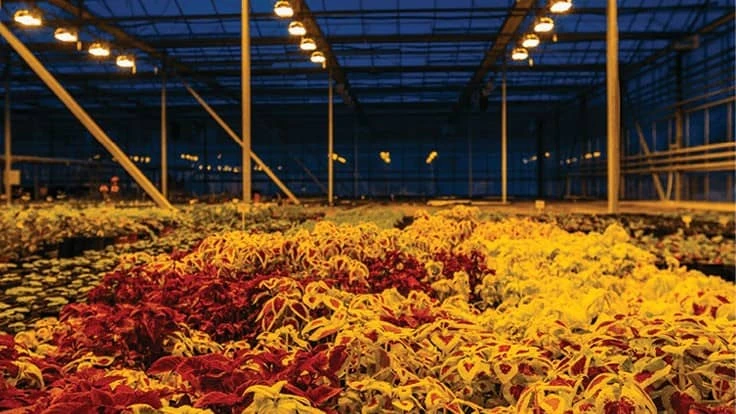

With just over two-thirds of commercial greenhouse managers surveyed indicating plans to replace, expand or invest in new supplemental lighting technologies in the next three years (67%), it naturally begs the question: How do you evaluate the many different options on the market today?
The University of New Hampshire Cooperative Extension recommends that growers set up small-scale trials throughout greenhouses to evaluate which species and cultivars are more profitable under supplemental lighting.
AJ Both, extension specialist at Rutgers University, has been undertaking advanced horticultural research projects since the late 1980s. His advice for commercial growers looking to conduct their own research on plant response to different types of lighting systems is simple Find an expert.
“It can be helpful to consult with an expert who understands plant lighting, because plant lighting is quite different from lighting applications for human environments,” he says.
“I think that conducting trials make a lot of sense when specific benefits are expected,” Both adds, noting that “there is some published research data that can be helpful, but the number of plant species and their cultivars is large.
“Chances are, conducting trials is the only way to determine what the optimum light environment is for a specific plant species,” he says.
Choose your sensor wisely.
Both notes that it is crucially important for those conducting supplemental lighting research to recognize the fact that different plants and cultivars respond quite differently than our own eyes to various sources of light.
Therefore, one cannot simply rely on human observations. Finding the right sensor to capture the right data set is key in any supplemental lighting trial.
“Don’t use a foot candle or lux meter, but instead use a quantum sensor,” he says. “A quantum sensor produces a reading that informs about the intensity of light that plants can use for photosynthesis.”
Once you zero in on the right sensor suite for your operation, a good place to start is using the sensors to obtain a solid understanding of the level of uniformity of light distribution over the entire growing area, Both says.
“Researchers typically achieve this through so-called light maps, which measure the distribution of light across a horizontal plane located some distance below the fixtures,” he says. “Measurements taken are then distributed across the measurement plane using a uniform grid, and simple statistical tools can then be used to calculate light uniformity across the entire area.”
Know your ideal spectrum.
Different plant cultivars respond independently to different spectrums of light. Some prefer red and blue spectrums during vegetative growth, while some need a healthy dose of infrared during flowering.
“If it is important to know something about the spectrum, or the color distribution, of light in the greenhouse, you can use a spectroradiometer,” Both says, noting the use of these instruments is not entirely common in commercial greenhouse applications.
“Ask for assistance from local researchers, or even from a lighting manufacturer who has experience in this area,” he says.
Identify variance across your canopy.
One of the most tangible benefits of conducting your own supplemental lighting trials is the ability to collect data in the same environment where the system will eventually be placed. This is often more valuable than research that takes place in a clinical setting where conditions are often more controlled than in a typical commercial greenhouse.
“When collecting these light readings, it is important to understand that in most cases light measurements will exhibit both spatial and temporal variation,” Both says. “In other words, time and location of the measurements taken are important.”
In order to diminish the influence of variation during the trialing phase, light measurements should be conducted over longer time periods (days, weeks, months) so as to reduce, or “smooth out” instantaneous variations, according to Both.
“As much as possible, sensors should be located where there is minimal shading taking place from the plant canopy, or even from stationary or moving overhead equipment like spray booms,” he says.
Both also notes that, when measurements are being conducted over long periods of time, sensor location adjustments are usually a necessary evil to ensure the data being collected is free of shadows and other obstructions throughout the process.
“This is also necessary when the canopy starts growing out and covering a sensor,” he adds.
Another issue that can pop up when trialing supplement lighting systems is the physical location of the experiment itself. Because the number of light sensors used during these evaluations is “typically small,” Both advises that “it becomes important to consider a location that is representative of a larger growing area.”

Explore the September 2020 Issue
Check out more from this issue and find your next story to read.
Latest from Greenhouse Management
- Anthura acquires Bromelia assets from Corn. Bak in Netherlands
- Top 10 stories for National Poinsettia Day
- Langendoen Mechanical hosts open house to showcase new greenhouse build
- Conor Foy joins EHR's national sales team
- Pantone announces its 2026 Color of the Year
- Syngenta granted federal registration for Trefinti nematicide/fungicide in ornamental market
- A legacy of influence
- HILA 2025 video highlights: John Gaydos of Proven Winners





